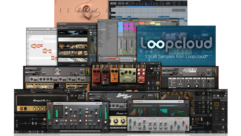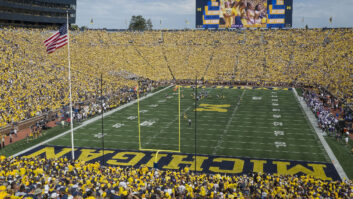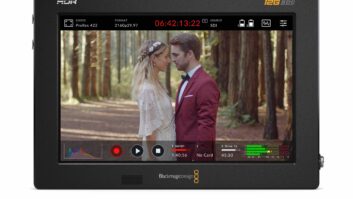
The Vanderbilt Commencement Ceremony Production, Part 2
Sep 8, 2014 11:14 AM,
With Bennett Liles
Listen to the Podcast

Podcast
Editor’s note: For your convenience, this transcription of the podcast includes timestamps. If you are listening to the podcast and reading its accompanying transcription, you can use the timestamps to jump to any part of the audio podcast by simply dragging the slider on the podcast to the time indicated in the transcription.
From Sound & Video Contractor Magazine, this is the SVC Podcast with Cody Heimann of Brantley, a full production company in Nashville, Tennessee. Show notes for the podcast can be found on the web site of Sound & Video Contractor Magazine at svconline.com.
The commencement ceremony at Vanderbilt University is a huge event, covered in HD by Nashville’s TNDV. The audio is handled by Brantley, a full production company in Nashville and Production Manager Cody Heimann is going to take us through the sound setup for both indoor and outdoor locations. That’s coming right up on the SVC Podcast.
Cody, thanks for being with us on the SVC Podcast for part two on the big Vanderbilt commencement ceremony. I watched a YouTube video on that and we talked with Nic Dugger of TNDV about the video setup for it. Now in part two we want to get into how the audio was done on it by Brantley. I’m sure it’s quite a bit more than just putting a mike on a podium and letting it run.
Yeah. No, not even close.
So was this the first time around on the Vanderbilt commencement ceremony for you or are you sort of an old hand at this one?
The company I work for, Brantley here in Nashville, they’ve been involved for almost 20 years on Vanderbilt’s commencement so we’ve had a lot of time to grow with them. I’ve been involved in four and then the last two years I’ve been the production manager. [Timestamp: 1:27]
All right. Well, the central clearing house for information on this show. Hopefully the production manager knows everything that’s going on. So sort of describe the audio setup on this. It looks pretty extensive. How many different sound sources do you have going on for this?
Well, you know, one of the key things for this is redundancy so pretty much everything we have we’ve got a backup. To really follow their ceremonial protocol, we’ve got three different lecterns that we use so there’s a backup for each one of those. They have a card reader system that reads off all the names so phonetically they’re correct instead of having a live person, so that’s a whole system we have to go through prior to the show as well making sure that works out. And then they incorporate their senior speaker into the commencement, so when we’ve had that – a couple of years ago we had First Lady Laura Bush; the year before that was Tom Brokaw – so press on that is crazy and people want to video record it and audio record, so we’ve seen up to 100-plus outputs just for that sort of situation. The way we kind of set up the show, we’re just fully over capacity on the lawn and in the gym, so we’ve got speakers all over the building. We fly a reverse line array to hit the back of the building. We’ve got delay sites that we have to run audio to. Some of those we do over a CAT-5 with a video balun that invents audio down that, so it’s just all sorts of stuff. [Timestamp: 2:54]
Wow, a card reader for the names. That sounds like a good idea but how does that work?
It’s basically a – I don’t want to call it like a Siri-type technology, but they input all of the names into this and they actually record in enunciation of vowels so this way, like I said, if there’s – instead of someone reading live and accidentally pronouncing a name wrong, this ensures that phonetically everything is absolutely correct as far as the titles. Some people are summa cum laude and all that can be very confusing when they’re reading that many names and that many titles to the graduate’s names. This just ensures that it’s mistake-free in theory. We’ve had where it’s messed up a couple of times and we have a backup mic for the chancellor so he can actually read the name if the machine ends up not working in some way, shape or form. [Timestamp: 3:48]
And how did you set up the PA versus the truck mix? Is that just another mix from the PA control or is it split with another person doing that?
Our front-of-house engineers for both the lawn and for the gym do anything fold back-wise and anything delayed or anything for overflow all from their console. But then we actually have a splitter set up to where we send the TNDV guys a completely separate multitrack coming from our gear and that’s where they can do the live stream and the video record and all that kind of stuff. They also take our two-track, though, so they can kind of have free reign to play with whatever they need to and whatever works best for them. [Timestamp: 4:27]
Yeah, a multi-track is a great idea since there are going to be a lot of recordings made of this event.
Yeah, and that’s one of the things is the show itself – or the actual ceremony – this year is was just under 18,000 attendees and graduates and that’s only about a third of what actually is involved with it. I mean the live stream has 20-plus, 30-plus-thousand people watching it and then with the YouTube views and stuff after it’s posted online it’s just astounding how many views they get on just the ceremony. [Timestamp: 4:56]
And what did you use for the front of house mixer?
So for both the lawn and the gym we used Avid SC48’s. They’re extremely versatile consoles to help us with the amount of outputs we need. They’re easy to expand and put in extra cards if we need to and it’s got the right amount of inputs for the job so it just – we didn’t want to go overkill and get something crazy and this really just did the job well. [Timestamp: 5:19]
And where is the audio control point for each one of these locations, outside and in the gym? Where they put you could really make a difference in the degree of difficulty.
Well, this is where the show starts to get a little interesting. We basically have to look at the show as a corporate gig. When you’ve got rock-and-roll shows the wire drops straight down from the PA and the console goes in the middle of the audience. We don’t get that luxury on this sort of thing and with an already difficult show, with just being outdoors in Nashville, the weather – you never know what’s going to happen. So to have open-lectern mics and delay PA’s and all that kind of stuff out on the lawn, our engineer would much prefer to be in the middle of the audience and listening there, but we actually have to put him backstage. TNDV gives him a TV monitor and he uses that to watch, but his tuning process prior to the show is an extremely integral part to what we do because after that he doesn’t really get to listen to it other than in a set of headphones. So he’s an amazing engineer and has done some great things with this ceremony. As far as the gym is concerned, we get to use a coach’s pit for the Commodore’s basketball games, so that’s all in the floor of the arena, so luckily he gets a little bit better of a spot. It’s still not optimal, but at least he gets to be in front of the PA for that. [Timestamp: 6:40]
Do they do any sort of live music or playbacks for any of the show?
Yeah. During the ceremony we’ve got the herald trumpets for the grand walk in, or the grand march. During the actual ceremony there could be anything. I mean we’ve had everything from harps to trumpets to violins to choruses and singers, any of that kind of stuff. Another interesting part about this gig as a whole is there’s eight other auxiliary schools that we do the commencement for on the same day at the same time and all those have full-blown setups as well; not nearly as big but we do a full audio setup and that sort of deal. All of those stages have full bands and orchestras and any of that kind of stuff, too, so it really is different from year to year and that’s one of the I guess most beautiful challenges of this gig is that we really get to be creative and on our toes at all times. [Timestamp: 7:37]
It’s a very select audience and everybody there is VERY into seeing their special person cross the stage and there’s no shortage of audience reaction; in fact it could get to be overwhelming. How do you pick up the crowd for the webcast without it just swamping whoever is onstage trying to talk?
Yeah, and that’s just one of the very difficult parts about this. We understand that this day for a lot of the audience members is one of the most important days of their lives, so absolutely perfect-sounding audio and great video from the TNDV guys is just so important. So the only thing we do with the audience mics is we send that straight to the truck so they can actually mix that down low for those times when it does get really intense inside of that room. We don’t obviously use that inside the PA at all and we really try to keep that on its own input to the desk to send out to the delay site so we can really keep that volume down when someone’s talking, so we can really mix that for other areas other than the main rooms. [Timestamp: 8:36]
Yeah, it would be very difficult to try to mix crowd sound being inside that acoustic environment. You’ve got to be someplace completely isolated from that.
Yeah.
So what kind of speaker setup did you have? They must vary between the inside and outside locations.
For the inside – for the gym – we used to run the EAW 760 line array, which is a great box. It’s really wonderful for arenas. It’s what we took out on our Iron Maiden tour for awhile. It’s a really, really great arena box. Then for outside we used the Adamson Y10’s, and also that’s supported by the Adamson SpekTrix for an under-hang box as well as a side fill. Two years ago when I started production managing this show we actually took the inside and the outside to all Y10’s. It’s a little bit more of a dynamic box and for something like this that has not rock-and-roll music or really loud music playing through it, it seemed like the better move and that’s something that I wanted to go towards. And it’s really working out good for us after the last couple of years, especially in a room like that gym which is an extraordinarily difficult room. It’s worked out really well for us and we’re very happy with the outcome. Out on the lawn we do 18 a side for the Y10’s and 150 feet down the lawn we do another set of left and right hang and that’s 12 a side. And then in the gym we just do 16 aside of the Y10’s and then we actually run the SpekTrix, which is the baby box of the Adamson Y10. We do 12 a side for an outfill inside the gym there. [Timestamp: 10:12]
Well, you said earlier that you never know what they’re going to come up with on any kind of live music. Do you provide any kind of stage monitoring for that? Is it that involved or do they really need that?
For the stage, as far as monitoring goes, we really don’t do a whole lot. We used to fill it up with monitors and really tried to reinforce that. Now we just do a single fold back on each side of the stage. We use the Adamson 121.5 biamp box. We just sit one of those on each side of the deck and we pretty much put all the vocals through it and all the music and it’s just enough to give them what they need, but without really amplifying the stage volume for anyone up there because a lot of the faculty and a lot of the staff aren’t used to a stage setup with the loud volume or anything like that. And a lot of the players are, like I said earlier, it could be a violin player or a harp player and there’s really no need for them to have a screaming loud stage either. So just that minor bit of fold back really works out well. [Timestamp: 11:13]
I know that at first it probably doesn’t come off as a big challenge just having somebody talking at a podium but you never know who’s going to talk or what condition they’re in so even that can be difficult sometimes.
Yeah. I mean with the amount of motions that fly through the ceremony, I mean you’ve got people that are just excited and you’ve got people that are excited to the point of tears and you’ve got people that aren’t used to speaking into a lectern mic and you’ve got people that are. So just the wide range and variety that we get makes it even more of a challenge. And like I said, out on the lawn is a lot more of a challenge than the gym. I mean our guys are used to having to be versatile with that, but out on the lawn any day in Nashville the weather could change at any second. So sometimes we’re dealing with a bunch of wind while trying to do the ceremony and sometimes it’s just really hot and people are speaking a little bit more lazily. So that’s just one of the more fun things about the show is that you never know what you’re gonna get and it’s just fun to stay on our toes like that. [Timestamp: 12:14]
Well, maybe the heat can sometimes work to shorten the speeches a little. I saw the YouTube video and you guys did a great job on it, sounds great and there’s no substitute for experience there. So that’s done and what other things have you got coming up at Brantley?
We actually just got back from a really, really fun show – and actually another very difficult one – that we worked with TNDV on as well for the Barbershop Harmony Society and it’s their international competitions. We do that every year and it changes. Last year it was at the Air Canada center in Toronto. This year it was at the MGM Grand in Vegas. It’s always an arena show and if you’re not familiar with barbershop it’s based around a cappella singing, so it’s four men singing around a microphone, or not a microphone when they’re not at the competition, trying to get the most sound between them and tonality possible. So we do that one and that’s a really fun one and a really difficult one that we deal with year after year. But as far as upcoming shows, we’re getting into awards season now so we’ve got the BMI Country Music Awards coming up, the BMI Gospel Awards, the NSAI Awards Show – all that kind of stuff that we’re gearing up for. [Timestamp: 13:26]
And all the awards shows come with their own set of challenges.
They always do. One of the biggest parts about those is just looks and cleanliness and all that kind of stuff, so we have to work extra hard up in the grid and in the ceiling to make sure everything looks really, really nice and clean on the truss and with the lights and the audio. And then on the stage, I mean pretty much have no cable whatsoever. That’s one of the biggest challenges of any awards show. But challenges are fun. That’s why we got into this business was to make all that stuff go away and just have a great time with concerts. [Timestamp: 14:00]
Well, maybe it gets dull when everything always goes just the way you expected. It sure was fun hearing about the Vanderbilt graduation ceremony and great for Brantley to team up with TNDV for that. Thanks for telling us about it.
Thank you so much for talking about it. We greatly appreciate it.
Thank you for being with us for the SVC Podcast with Cody Heimann. Show notes are available on the web site of Sound & Video Contractor Magazine at svconline.com. Be back with us right here for the next SVC Podcast.










